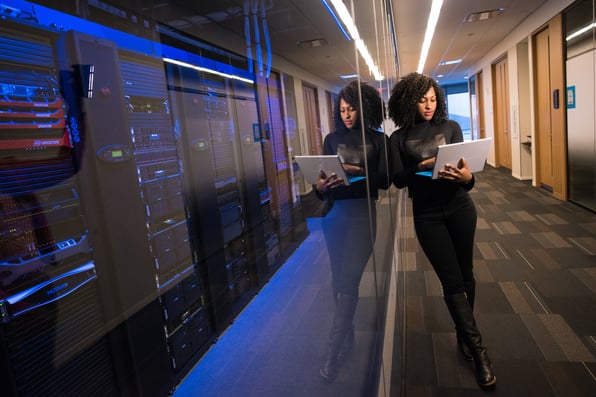
Digital Transformation Predictions for 2021: A Talk with Ripcord Experts
A lot changed in 2020. The ways in which we work, socialize, and learn are just a few of the newly altered aspects of daily life. But in 2021, even more changes will come.
As part of a large-scale, worldwide acceleration brought about by COVID-19, we can expect to see knowledge workers continue to perform their jobs from home and otherwise remotely. And we will probably see companies across markets adhere to slimmer office- and retail-space budgets.
However, the pace of pandemic-spurred change may be fastest in the digital arena. We sat down with two of our experts in the field and gathered the top five digital transformation trends likely on their way in 2021.
Prediction 1: Less Paper. Finally.
The limitations of paper-based systems have been known for years, but COVID-19 and the associated work restrictions really brought them to light. The pandemic "caused a lot of companies to put a spotlight on what makes their business run," Kevin Hall, Ripcord co-founder and CTO, said. Many "processes weren't as digital as they needed to be to support the kind of work we were all required to do over the last year."
The reliance on paper meant many industries and their customers were hamstrung at the start of the global spread of the virus, before they'd learned to pivot and adapt. Players in banking and insurance, for example, "realized that paper has been a crutch that they've leaned on" to their and their customers' detriment, Hall said. "A lot of customers we talked to and peers we have saw significant issues with realizing how prevalent paper is" in opening a bank account, getting a mortgage and more."
He referenced Japan as a potential model for the rest of the world when it comes to making great digital strides quickly. The island nation’s businesses and governments have remained in many ways staunchly, unfalteringly paper-based — despite Japan’s technological leadership in other areas.
"While the world may see Japan as a futuristic land of humanoid robots and intelligent toilets, inside its offices, managers maintain a fierce devotion to paper files, fax machines, business card exchanges, and face-to-face meetings," Ben Dooley and Makiko Inoue wrote in an April 2020 New York Times piece on the widespread use of hanko, the personalized, signature-replacing stamps still required on documentation at the majority of businesses and offices in Japan.
Since the pandemic, there has been pushback against the continued use of this paper-based system, with some measure of success. In recent months mandates for hanko have been lifted at some universities and companies. "COVID-19 has highlighted how Japan’s paper and seal culture impedes productivity, and even puts people’s lives at risk," a May 2020 Nippon.com piece reads, in part. "The post-coronavirus era promises to continue the reforms made during the crisis."
Hall seconded this projection for 2021 and beyond, and outlined some of the reasons moving away from paper is so important.
"It's not as easy as just flipping a switch and now there's no more paper," he said. "If you can capture data at the time of printing, you'll both get the metadata sooner [and] you can also avoid having to print the paper and mail it somewhere, which is costly and could lead to errors."
Prediction 2. Better Data Connection
Also arriving this year: shored-up connection-making between data points.
"A lot of technologies coming to market are making it easier for companies to connect data that's historically been trapped or inaccessible into their broader corpus of data and really start to take advantage of that," Hall said.
He gave manufacturing and its factory-generated data as one example. In 2021, manufacturing companies are likely to "start gathering data and putting it into a platform or toolset that makes it easier to ask questions of that data." In this way, companies will be able to link new data to older information that has been 'trapped' in paper.
Prediction 3. Machine Learning Will Create a Strategic Divide
Going forward, when it comes to digital transformation, there's going to be a noticeable difference between the haves and the have-nots, between those businesses that have machine-learning capabilities and those that don't.
In 2021 "a strategic gap will form" between non-ML-embracing entities and companies that have purchased or developed machine-learning infrastructure to ease the training and management of models, Hall said.
Prediction 4. More Automation Is Coming
Robots using ML are also likely to further deepen this chasm, according to Ahson Ahmad, chief product and customer officer at Ripcord. Ahmad said the use of robots will increase this year as well.
"With the need to keep people out of close quarters, I think we're going to see some significant investment in automation in non-traditional areas," he said. These will include robots that take on essential-worker tasks to help employees work remotely. Such scenarios include a machinist controlling machinery from home or elsewhere off-site and a security guard controlling a robot sentry. "They're still human-controlled or -assisted but they can do those tasks for you," Ahmad explained.
Predictions from IT services management company Gartner mirror this one.
"AI is already automating large parts of routine work to direct employee focus toward higher value, nonroutine work," a Gartner press release from late 2020 reads, in part. "AI and robotic process automation (RPA) technologies in the enterprise are expected to accelerate and have the potential to automate large swaths of routine work when the duties are fast, known, and repeatable."
Prediction 5. Consolidation of Tools Will Happen
In recent years, a fair amount has been written about the many benefits of so-called "water-cooler talk" to both a company and its employees. With the coronavirus-spurred trend toward telework, this year and in coming years, we can expect such conversations to go digital.
Calling the lack of social interaction with coworkers that is inherent with a distributed workforce a "micro problem" for businesses, Ahmad reaffirmed previous years' technological attempts at solving the issue, but he said disparate solutions are on their way out, while "consolidation" is in.
"We've seen lots of digital tools try to solve these micro problems ... Slack, Zoom, and the like," Ahmad said. But this year and beyond the world will begin to see "a larger consolidation" of tools. That will mean a move from unconnected "microtools" to suites of connected solutions that will propel digital transformation forward.
Let Ripcord Speed Your Digital Transformation Efforts
At Ripcord, we're on a mission: to transform the world, industry by industry.
With proprietary vision-guided robots, AI and machine learning, Ripcord solutions digitize, enrich, and organize an entity's most important documentation, no matter the volume. We'll save your company time and money and free up your employees for the kind of work only humans can do. Contact us today to learn how we can help your company.
/Ripcord%20Logo%20-%20Color%2011.png?width=2000&height=620&name=Ripcord%20Logo%20-%20Color%2011.png)



